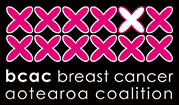BCAC applauds a campaign which has seen a massive increase in mammogram screening for Chinese and Korean women in the Waitemata region of Auckland.
Breast screening uptake has soared by an extraordinary 88 per cent among Chinese and Korean women in the Waitemata District Health Board area in the three years to 2011.
The increase follows a campaign by BreastScreen Waitemata Northland (BSWN) and Waitemata Asian Health Support Services (AHSS), which targeted the region’s Asian population.
Around 13 per cent of the region’s population identifies as Asian and in 2007 only 43 per cent of eligible Asian women were getting mammograms.
In August 2007, BSWN and AHSS collaborated to design and implement culturally and language-appropriate interventions to enhance access to and improve breast screening uptake for the region’s non-English speaking Chinese and Korean women.
Interventions included:
- developing promotional materials such as brochures, posters, flyers, and letters
- advertising the breast screening service and the cultural and language support service offered by AHSS in popular Chinese and Korean media outlets
- sending translated flyers and invitation letters to Chinese and Korean women to let them know they could make breast screening appointments through AHSS bi-lingual staff or the traditional 0800 BreastScreen Aotearoa (BSA) number
- seminars for Chinese and Korean women
- promotion of breast screening through general practices and at community events
- a phoneline to enable non-English speaking Chinese and Korean women to contact AHSS bi-lingual staff directly to make breast screening appointments
- completing the eligibility form for women over the phone and making and confirming clinic appointments for them immediately via the BSWN patient management system
- providing the choice of individual or group appointment bookings
- organising interpreters for individual or group appointment bookings at the Takapuna or Waitakere clinics – up to seven breast screening clinics a month for 8 to 10 women per clinic
- organising interpreters for individual or group screening sessions to assist women with form filling and during the screening process
- actively reminding non-English speaking women two days before the breast screening appointments and following up any ‘did not attends’
- training AHSS bi-lingual staff in the BSA programme, key media messages and managing media questions, completing forms over the phone, and making clinic appointments via the BSWN system.
Coverage for the region’s eligible Asian women increased to nearly 66 per cent from 2008 to 2010, and achieved 70 per cent by the end of May 2011, exceeding the target for the period. This was an 88 per cent increase over three years.
Service Manager Asian Health Support Services, Sue Lim, says it was important to both promote the service and improve access to it. “Having two alternative helplines with both Chinese and Korean bi-lingual staff was a major factor in the project’s success, as was the fact that the service is free for eligible women.
“Screening as a preventative intervention is not well promoted in Asian countries so there are issues around understanding why it’s important.
“We created a one-stop-shop for women. They could enquire by phone. We filled out their eligibility form for them and made an appointment straight away via the BSWN system, with the choice of an individual or group appointment. And the women knew they have would have access to interpreters at the appointment.”
Women were also phoned two days before their appointment to remind them, resulting in a ‘did not attend’ rate for Chinese and Korean women of just 3.4 percent, well below the overall Waitemata patient rate target of 10 percent.
Ms Lim says there is an increasing need for the DHB to respond to the culturally and linguistically diverse patient populations.
“Research tells us that language and cultural barriers have a significant impact on equitable access to appropriate and quality care. This collaborative project provides a useful framework for designing and implementing breast screening services for women who are culturally and linguistically diverse and have lower rates of mammography.”



